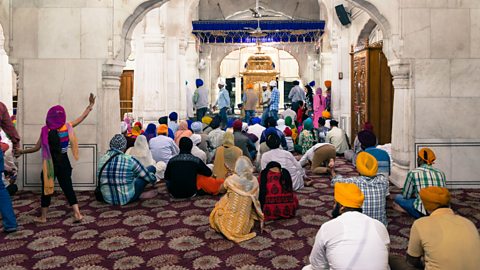The gurdwara
The Sikh place of worship is known as the gurdwaraSikh place of worship. Literally, the 'doorway to the Guru'.. This translates as ‘the door of the Guru’. All gurdwaras display the Nishan SahibSikh triangular flag. flag, on which appears the KhandaSymbolises the Sikh faith: it shows a double-edged sword, a chakram and two single-edged swords. , which is the symbol of Sikhism.
The gurdwara is not only a place for meditation and prayer. It is the main place for the Sikh community (the sangatCongregation in a Sikh gurdwara.) to gather together and it is also a place where Sikhs and the wider community can learn about the faith. It is a relaxed place of worship and there is no expectation for Sikhs to attend the gurdwara at all. However, because it is a place of community where people are made welcome, many Sikhs choose to attend the gurdwara on a regular basis.

Key features of the gurdwara
- The gurdwara can often be entered through four doors, which reflects the belief that everyone is welcome.
- There is a diwan hallThe main hall in a Sikh gurdwara where worship takes place., which is the prayer hall and the main room of worship.
- Within the hall, the Guru Granth SahibThe Guru Granth Sahib is the most important Sikh holy book. It is a collection of songs, prayers and hymns from the Sikh Gurus and other holy men, as well as teachings from other faiths. It is treated as a living Guru. is placed on the Manji Sahib, a small platform.
- Sach KhandThe 'realm of truth'. An individual's union with God. Can also refer to the room where the Guru Granth Sahib is placed overnight. is the name of the restroom for the Guru Granth Sahib. At night, the Guru Granth Sahib is put to bed in that room. This is an important daily event in the gurdwara where the Guru Granth Sahib is carried to the Sach Khand and covered with a rumallaBeautiful cloths or coverings which cover the Guru Granth Sahib when it is not being read..
- Each gurdwara has a langarThe kitchen and place where food is eaten in a Sikh Gurdwara. Often volunteers provide and cook food that is served to all as an act of sewa (charity)..
- Golak is the collection box for donations from the sangatCongregation in a Sikh gurdwara.. The golak is usually placed in front of the Guru Granth Sahib in the diwan hall.
Showing respect in the gurdwara
To show respect in the gurdwara, Sikhs wash their hands, cover their heads and remove their shoes before they enter the diwan hall. They then walk towards the Guru Granth Sahib, bow in front of it and touch the floor to show respect. They may also give a donation, which is placed in the golak.
In the hall, Sikhs sit on the floor to show respect to the Eternal GuruThe Guru Granth Sahib, known as the Eternal Guru because God would be present through its teachings.. Men and women often sit separately.
Worship in the gurdwara
The sangat sing hymns and listen to sermons and talks. Worship can be led by any Sikh who is knowledgeable about the Guru Granth Sahib. All services start and end with the ArdasPrayer. The formal prayer offered at the end of most Sikh worship. prayer.
Kirtan
kirtanDevotional singing of the compositions found in the Guru Granth Sahib. is the singing of hymns and shabadA hymn or verse in the Guru Granth Sahib. (verses) from the Guru Granth Sahib. The shabads are sung with music, which is played by ragisMusicians who sing or play accompaniments for kirtan (hymns) in Sikhism..
At the Gurdwara, the Guru’s Gate, the Kirtan of the Lord’s Praises are sung. Meeting with the True Guru, one chants the Lord’s Praises.
(Guru Granth Sahib 1075)
Karah Parshad
Karah PrashadSanctified food ( a sweet pudding made from wheat flour, sugar, clarified butter and water) distributed at Sikh ceremonies. is blessed food. It is distributed to everyone at the ends of services and symbolises the belief in equality and the oneness of humanityThe Sikh belief that all humans are equal because Waheguru created everyone equally.. It reminds Sikhs of the langar and the idea that all people are God’s creation. Everyone is encouraged to take some Karah Parshad, as this symbolises the idea that no one should leave empty handed.